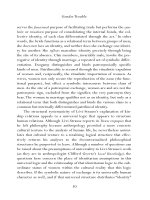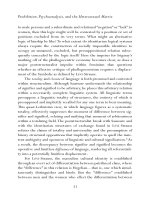GENDER TROUBLE 29
Bạn đang xem bản rút gọn của tài liệu. Xem và tải ngay bản đầy đủ của tài liệu tại đây (26.16 KB, 1 trang )
Gender Trouble
masculine position.The radical dependency of the masculine subject on
the female “Other” suddenly exposes his autonomy as illusory.That particular dialectical reversal of power, however, couldn’t quite hold my
attention—although others surely did. Power seemed to be more than
an exchange between subjects or a relation of constant inversion
between and subject and an Other; indeed, power appeared to operate
in the production of that very binary frame for thinking about gender. I
asked, what configuration of power constructs the subject and the
Other, that binary relation between “men” and “women,” and the internal stability of those terms? What restriction is here at work? Are those
terms untroubling only to the extent that they conform to a heterosexual matrix for conceptualizing gender and desire? What happens to the
subject and to the stability of gender categories when the epistemic
regime of presumptive heterosexuality is unmasked as that which produces and reifies these ostensible categories of ontology?
But how can an epistemic/ontological regime be brought into
question? What best way to trouble the gender categories that support
gender hierarchy and compulsory heterosexuality? Consider the fate of
“female trouble,” that historical configuration of a nameless female
indisposition, which thinly veiled the notion that being female is a natural indisposition. Serious as the medicalization of women’s bodies is,
the term is also laughable, and laughter in the face of serious categories
is indispensable for feminism.Without a doubt, feminism continues to
require its own forms of serious play. Female Trouble is also the title of
the John Waters film that features Divine, the hero/heroine of Hairspray as well, whose impersonation of women implicitly suggests that
gender is a kind of persistent impersonation that passes as the real.
Her/his performance destabilizes the very distinctions between the
natural and the artificial, depth and surface, inner and outer through
which discourse about genders almost always operates. Is drag the imitation of gender, or does it dramatize the signifying gestures through
which gender itself is established? Does being female constitute a “natural fact” or a cultural performance, or is “naturalness” constituted
xxviii









